Nova Delphini 2013 was discovered on August 14 14:01 UT by Koichi Itagaki, Yamagata, Japan, using 0.18m reflector. It was magnitude 6.3. It rose in brightness hitting about magnitude 4 on the 16th UT. 24 hours later it had faded down again to magnitude 5. The moon is getting closer and brighter so it is now a difficult naked eye object. The latest light curve can be found on the AAVSO website: http://www.aavso.org/lcg/plot?auid=000-BLC-933&starname=NOVA%20DEL%202013&lastdays=30&start=2456518.157746227&stop=2456531.157746227&obscode=&obscode_symbol=2&obstotals=yes&calendar=calendar&forcetics=&grid=on&visual=on&r=on&bband=on&v=on&pointsize=1&width=800&height=450&mag1=&mag2=&mean=&vmean= .
It was murky here the night of the 15th UT but I managed 3 color frames before the murk got too bad. The following night it was near maximum brightness but before I could get anything the murk did me in. It was easy naked eye before the gunk got to me. I should have been getting data rather than looking naked eye but it seems I never look at the sky any more, just the monitor. It was easy to see with the arrow of Sagitta pointing right at it. High clouds are a problem again tonight and with the bright moon nearby conditions will be poor so I decided to process the three color frames I got on the 15th at about 4:30 UT. What little I got through the murk the following night showed it to be at least a magnitude brighter and much bluer.
The last nova in Delphinus was in 1967. That one hung around at near maximum brightness for many weeks. As my log from August through October shows it actually was brighter at about 4.5 at the end of October than it was in August when I first learned of it. It was about one magnitude fainter then. Weather and it being low at sunset blocked any view after that. I don't find it in notes from 1968. It still shines about magnitude 13 after taking several years to fade to that level. Are we seeing the companion it is stealing matter from rather than the white dwarf that blew? I haven't researched it.
I've included my image from August of 1967 taken from my drive in the Lincoln, Nebraska. I used a Polaroid camera on the dec axis of my 10" f/5. That was about as close to digital imaging as you had back in 1967. At least you saw your result nearly immediately. Film was very slow. The exposure was 10 minutes just to get what I did. The blue layer seems to have had less reciprocity failure than the other layers as any faint star came out blue as did the sky background. The lens, while "slow" still had lots of off axis distortion. This image is a heavy crop of the full frame and is near the top of the frame where this distortion is obvious with this much enlargement. Much of my house was in the full frame. Still it worked well to monitor the nova. I've marked on that image the location of Nova Delphini 2013 46 years later.
14" LX200R @ f/10, RGB one 10' frame each color, STL-11000XM, Paramount ME
I then managed to take another image when clouds cleared nearly a month later on Septemver 23, 2013. By then the hydrogen shell it emitted was coloring the star with the red light of ionized hydrogen.
September image also used 1 10' frame for each color to keep it similar to the August 29 image except for what was lost to clouds in the August image. I tried to match the field stars but it appears they are still a bit brighter in the September image which had no cloud issues. | 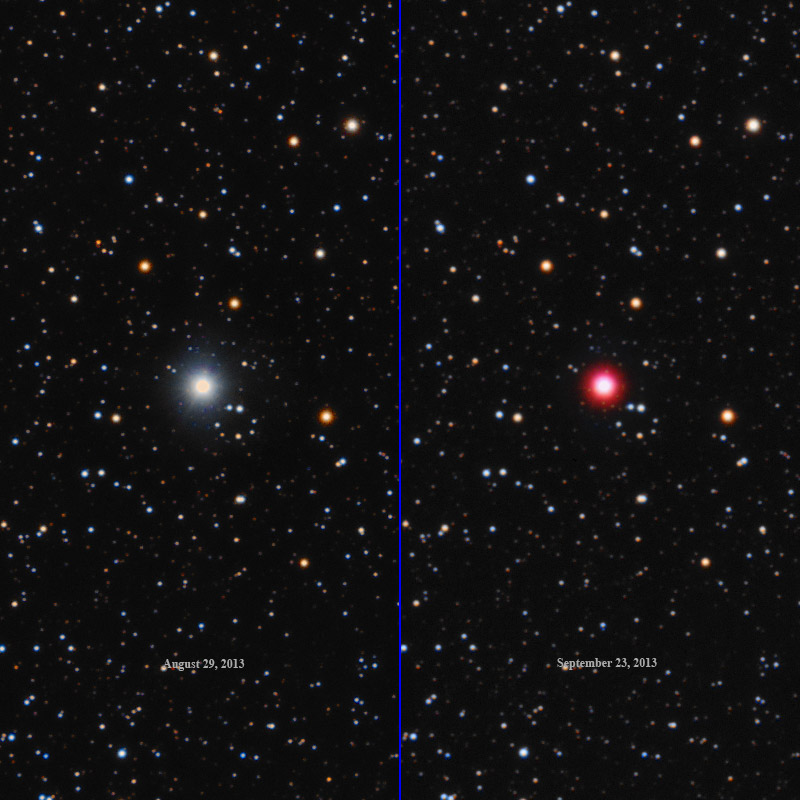
NDAugustAndSeptember.JPG
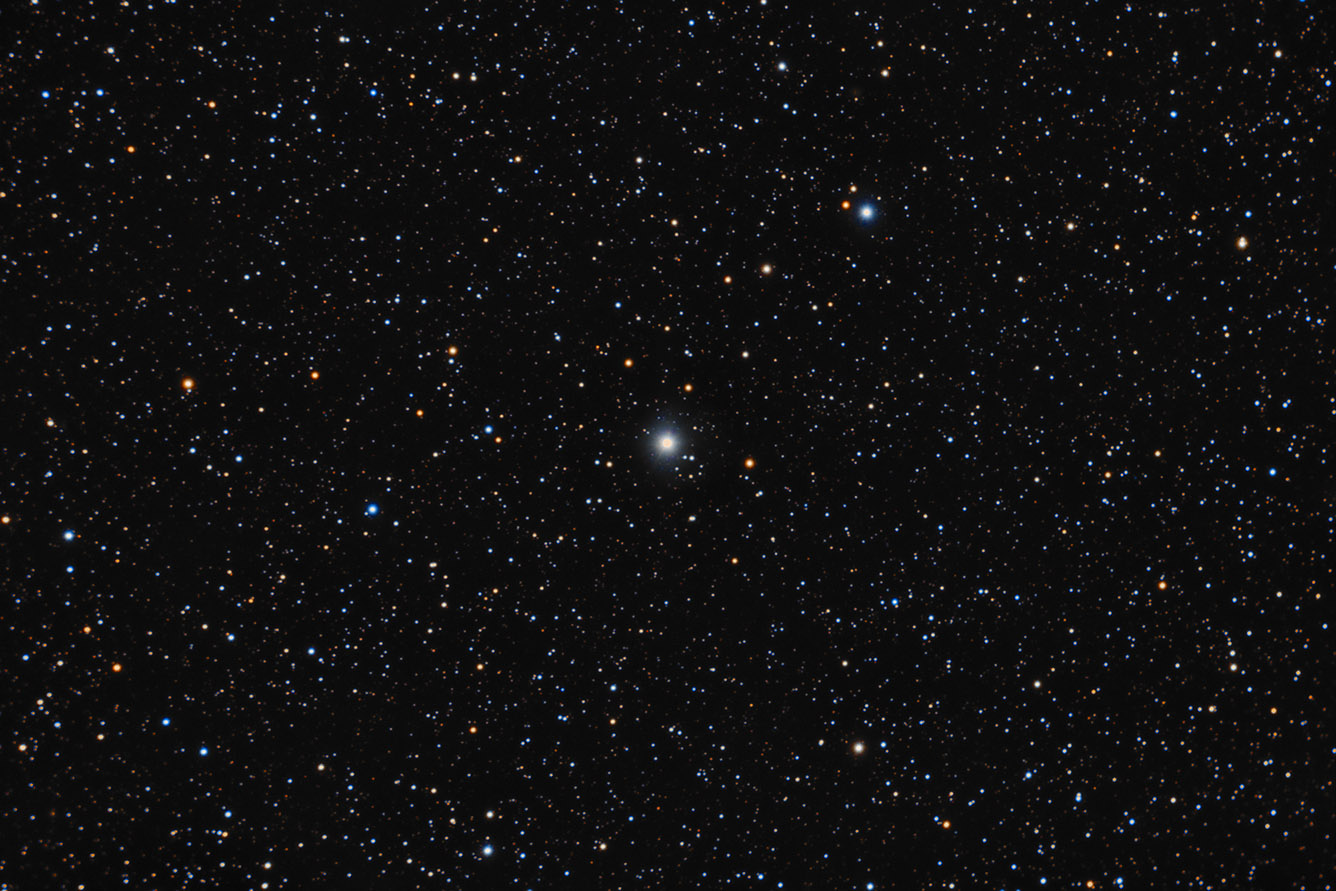
NOVADELPHINI2013RGB1X10-67.JPG
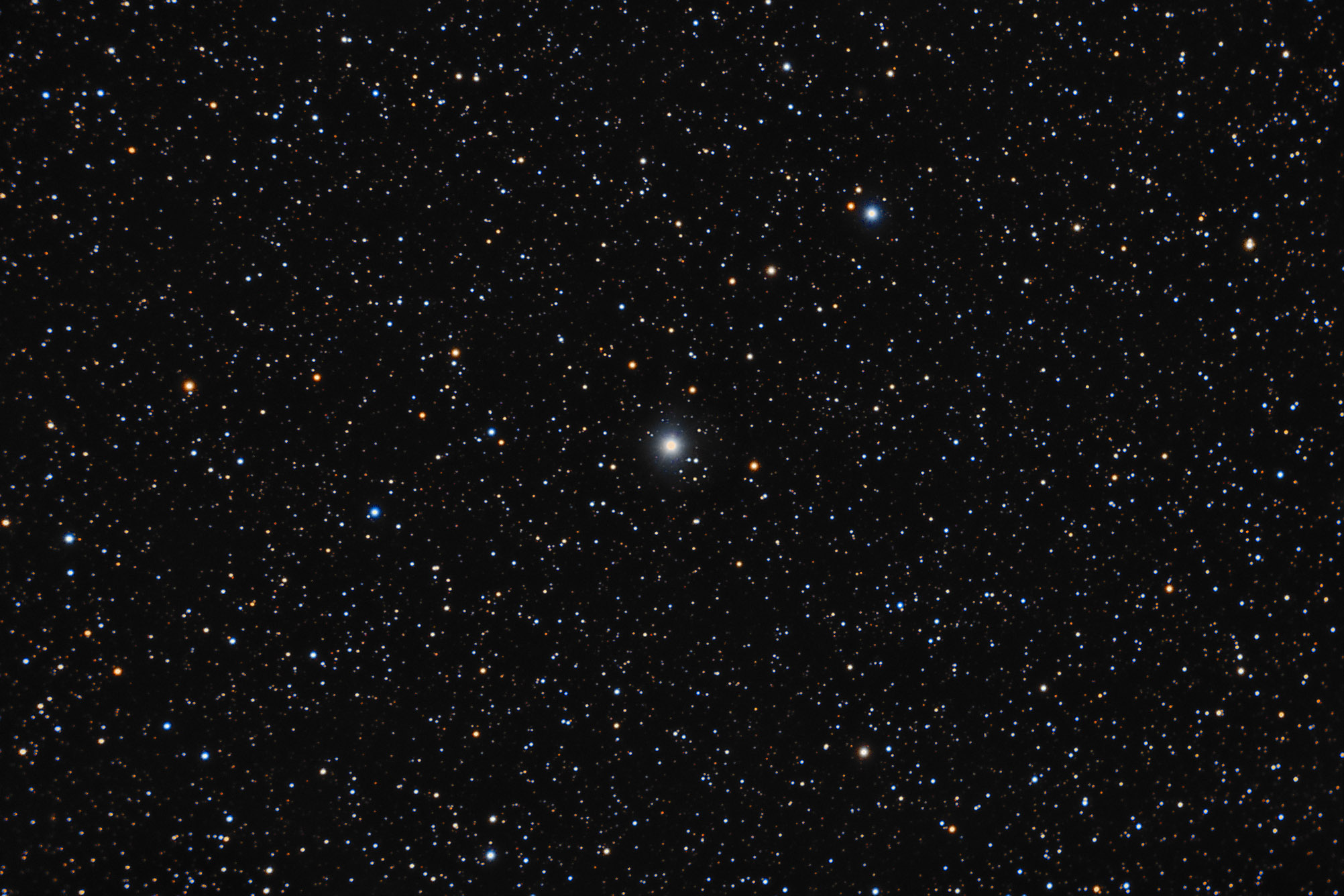
NOVADELPHINI2013_RGB1X10.JPG
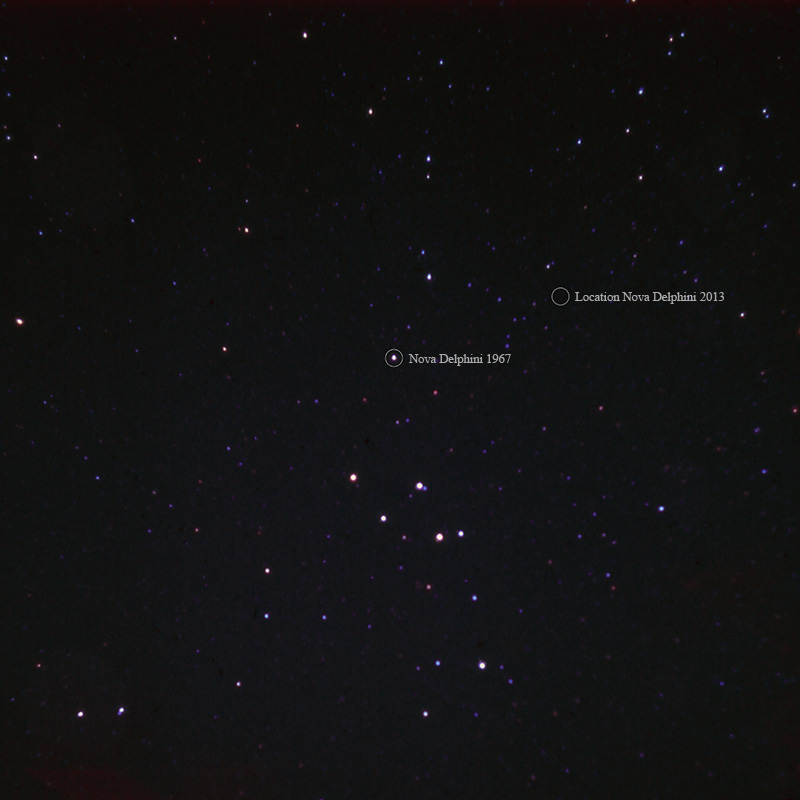
Nova_Delphini1967-800c.JPG
| Nova Sagittarius No. 4 (how's that for a name) was just discovered. Since I thought I had a clear night I decided to give it a try. It is at 18h 20m 27s -27d 44' 27s so well below my limits. It is also below the walls of the observatory and in the trees along my shore, I can't trim as they are in the shoreline impact zone. So this was an interesting image compounded by the sky suddenly turning partly cloudy. At no time was more than the top 4" of my objective above the observatory wall. So while I was using a 14" scope I probably had only the equivalent of about 5" or so of true light gathering power. Then being so low and in the gunk, everything is severely extinguished. Color balance is also a WAG as the amount of wall obstruction got worse with time. I had to use 1 minute frames to catch what I could between tree branches and clouds. It didn't help that some fisherman was using a bright light to see his fishing buoy. It is illegal to use a light to attract fish except you can use a lighted marker buoy. Or, as this guy did, you circumvent the law by shining a 3 million candlepower light on your buoy so you can see it. That it attracts fish illegally, well, that's just a side effect. DNR folks can't cite him as he was just using a light to see his buoy which is allowed. That reflected into the observatory lighting up the wall thus fogging the image.
Due to severe atmospheric chromatic smearing caused by imaging so low I couldn't use any luminance data. It just resulted in prism smeared stars. So this is a pure RGB image. I debated using the red channel for the luminance as it was the cleanest due to fewer issues from tree branches and less extinction but it so distorted the brightness of some of the blue stars I gave that up and went with pure RGB.
I get a magnitude of 8.3 in red light but due to all the issues, I doubt it is all that accurate. Probably within a half magnitude at least, probably a bit better than that. Compared to known stars in the image, I was within 0.2 magnitudes most of the time. This was taken and is reproduced at 1.5" per pixel binned 3x3. Dimmest stars are about 16th magnitude, far from my usual limits!
I've included a POSS image from the 1960's showing no star visible at the location of the nova.
14" LX200R @ f/10 with severe wall obstruction. RG=6x1x3' B=5x1x3', STL-11000XM, Paramount ME | 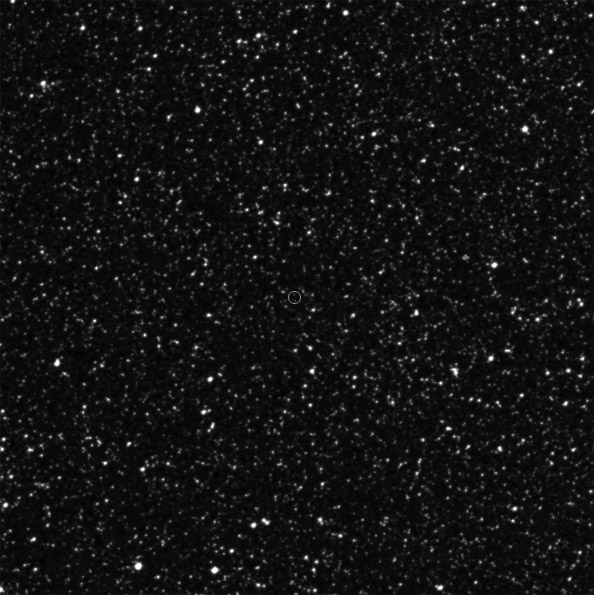
DSS_RED.JPG
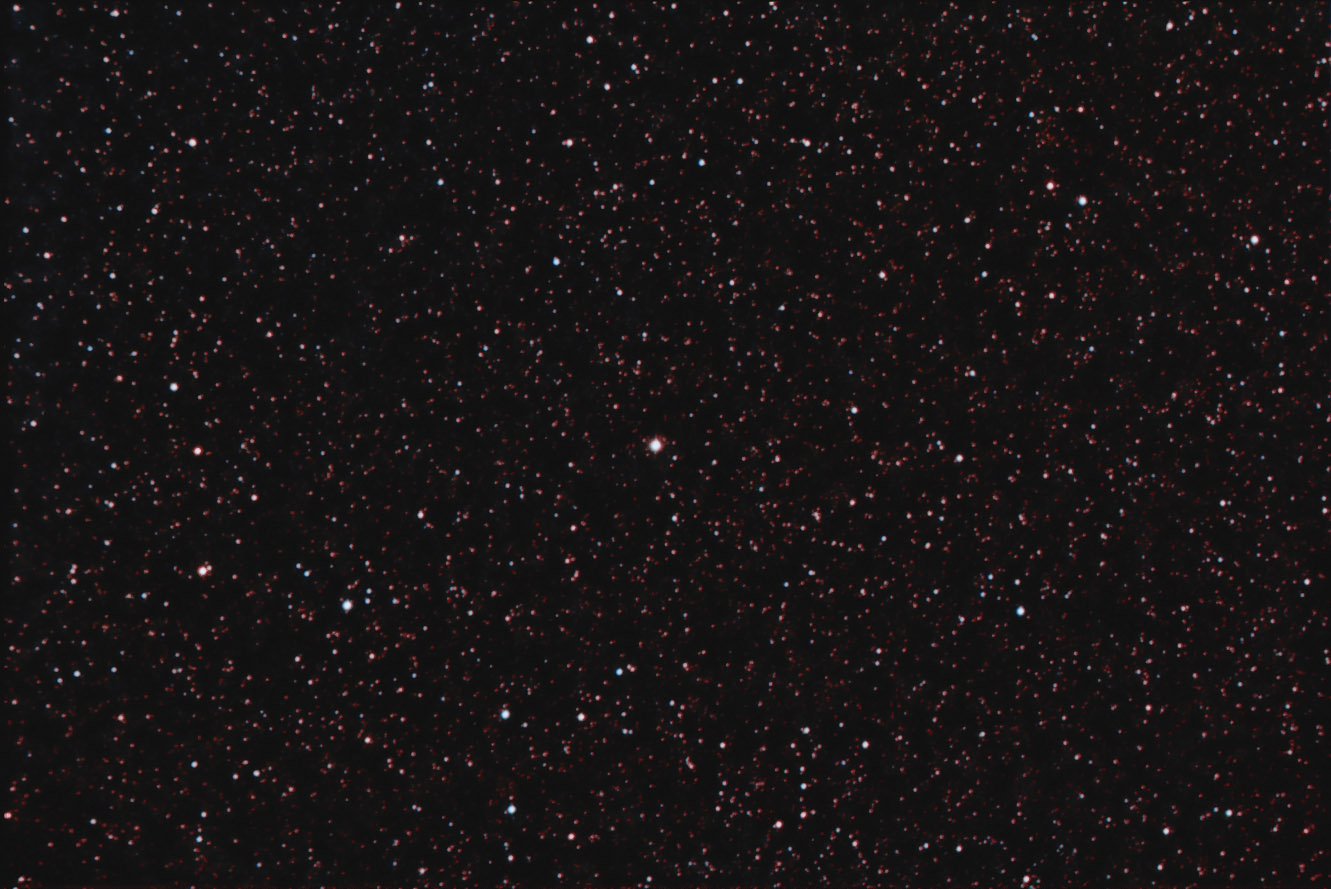
NovaSagittariusNo4.JPG
| I've been interested in astronomy since watching a total lunar eclipse in September 1950. I used only binoculars until I started building a 6" reflector in the fall of 1953 finishing it in the spring of 1954 in time for the Mars opposition that summer. I was disappointed not to see the canals. Shortly thereafter I took my first astronomical image by holding a 35mm camera up to the eyepiece while the scope was pointed at the moon. That didn't turn out well and no longer exists.
I read about how to track the stars with a 35mm camera and a barn-door "drive". Basically, its two pieces of wood with a hinge pointed at the pole and a threaded screw that pushed them apart such that one turn of the screw matched one minute of clock time. It worked surprisingly well. Tired of sitting and turning a screw constantly I rigged a 1930's spring driven alarm clock's gears to do the turning for me. Neither system survives. Nor do the pictures but I sure had fun with it.
During this time I acquired several other telescopes ranging from a 2.4" refractor (very good quality), a 3" plastic "Moon Scope" I was given by a well-meaning relative (soon sold) and by the late 50's a 10" f/5 Cave Astrola. It was a great deep sky scope but due to poor optics, I later added a 10" f/8 tube for the same amount. Later I found the secondary of the f/5 was 2 wave and the cause of the poor performance. I replaced it and rarely used the f/8 after that though still have both. I used both for deep sky work and the f/8 for planetary imaging for many years. I also bought a used Questar plus a 35mm camera and complete color darkroom at a garage sale for $500 and an Optical Craftsman 6" f/4 that far outperformed the Questar. It too came from a garage sale, this time for $100. I still have these as well. I also added a 2.5" f/6 refractor of fair quality due to severe color issues but with a yellow filter worked well for wide field imaging with Tri-X.
Over the years I experimented with all sorts of ways to "speed-up" film. If dry ice was good then was liquid nitrogen better? Well, it was better and destroying a camera. I soaked film in an ammonia solution at 150 degrees ruining an oven until hypering Tech Pan 2415 and using color filters to make color images. This replaced High-Speed Ektachrome (ASA 160) I used before that. The Cave mount had a severe periodic error and was replaced first with a Byer's drive using the same mount and then a home built mount, thanks to a machinist friend who did much of the work, based on a commercial mount. These all were in the AC era though the declination drive was DC in the newer mount. I used this until the early 90's when arthritis made hauling into the country difficult. Of course, the family was also an issue though by the 90's it was arthritis that was the limiting factor.
During this time I was a supervisor for 27 years at Hyde Memorial Observatory in Lincoln. With travel to the country difficult my dream was to move to a dark site and build an observatory of my own for mostly imaging rather than visual astronomy which had been my major interest for over 50 years. This site is the result of the dream coming true. See the page on the observatory for that story. | 
NoOneOutThere.jpg
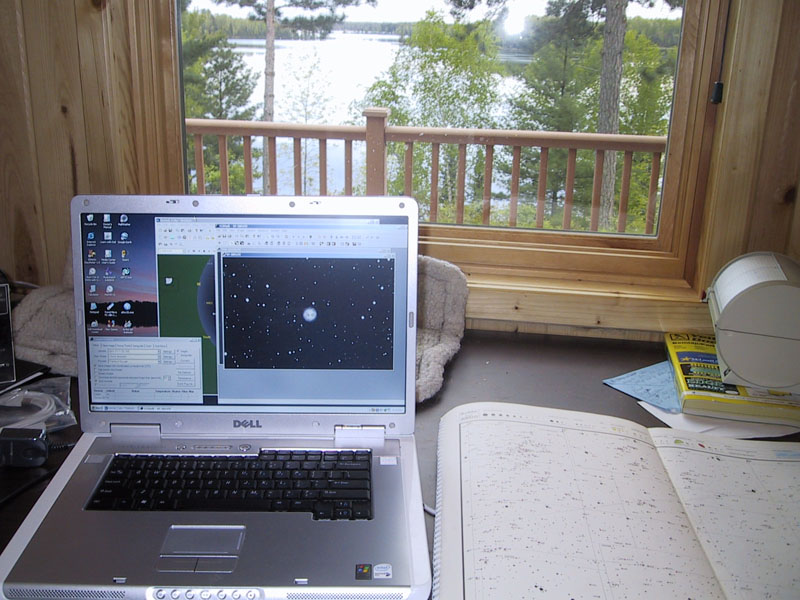
OperatorPosition.jpg
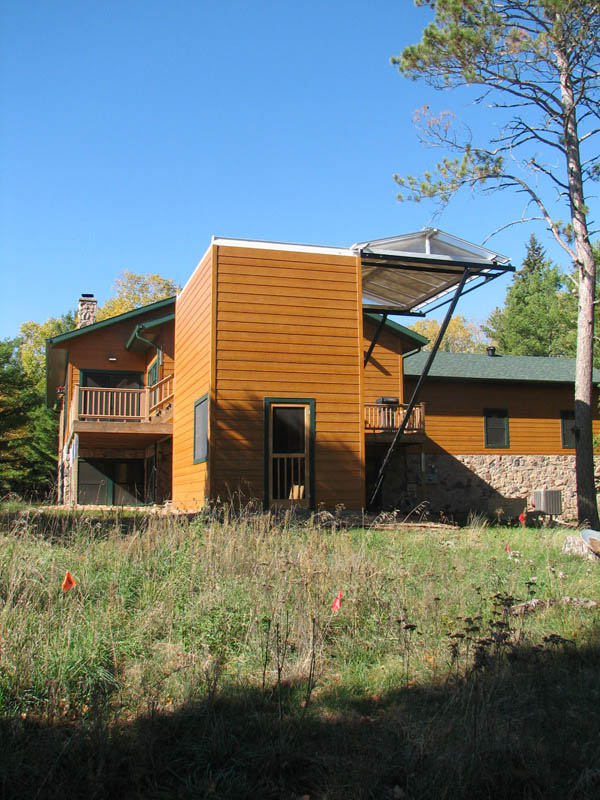
RoofOpen.jpg
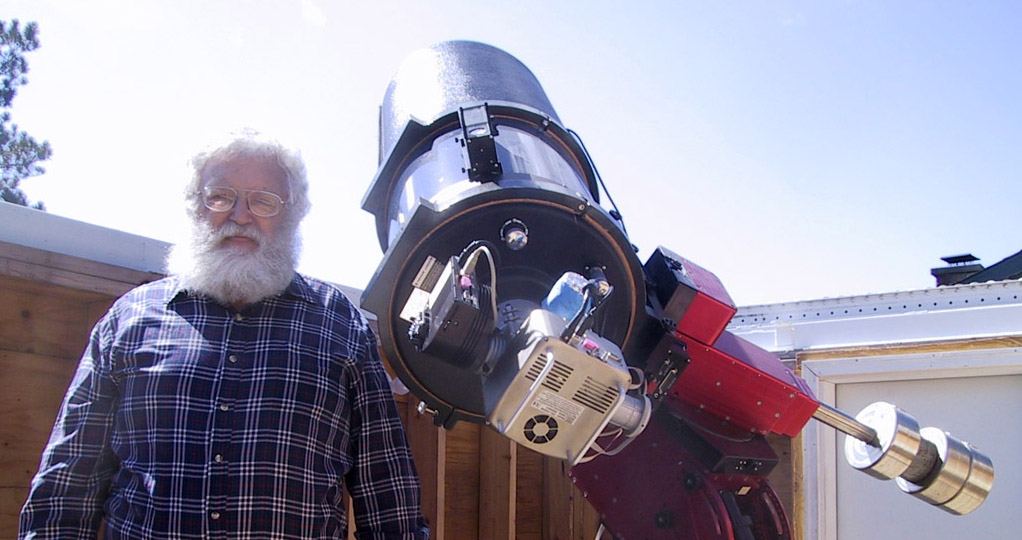
TelescopeAndMe.jpg

TheRoadIn.JPG
| This is Pickering's Triangle, well a small part of it. Turns out to be way too big for my system. So I never took any color data. It is way too faint to take without using H-alpha filters which I didn't do, unfortunately. This made me dig into the noise to get what I did get. That is not easy due to the flat problem I was having at the time due to a loose screw in the camera preventing filters from aligning properly each time, so I cropped and reduced the image to hide problems with the flats. Still, it is an interesting picture. This is part of the Cygnus loop complex which covers an area of the sky 6 full moons across so way too big for my system. I can't even fit one full moon into my field of view, let alone 6 of them. The nebula is formed by the interaction of the shock wave from the supernova hitting interstellar gasses. At one time it was thought the supernova blew about 100,000 years ago but of late it is thought to be much newer. Most now think it happened 10,000 or less years ago. We've never found the neutron star or black hole that was created by the explosion. The shock wave is the only evidence of the explosion.
14" LX200R @ f/10, L=10x10', STL-11000XM, Paramount ME | 
P-TRIANGLE10X10_67.jpg
| 103P/Hartley (Hartley 2) taken October 2, 2010
The moon is out of the sky for a few hours now and I hoped to get this comet. Last night, like the night before, was perfectly clear at sunset but soon after I started in on the first object that they ruined the night before we had a repeat performance. But by 1:30 a.m. they had cleared again. By this time I'd swing the scope to the position of the comet which I'd catch glimpses of through the clouds. With the clouds out of the way, I started imaging but quickly realized I'd forgotten to turn on the "track object" button so it was still pointing where the comet was a few hours earlier. Not only that the comet was blurry from its motion in only 2 minutes. Stop that series, turn on tracking based on its orbital elements and I managed 6 2 minute images. It was near the meridian, the moon was starting to give problems so I knew I didn't have much time so used 2 minute shots not to lose much before it hit the meridian stop. Got in 6 frames. By this time the moon was hurting so much additional data wouldn't add anything so shut down. Here are the 12 minutes of data on the comet I was able to get. Star trails show it is really moving up there. To get as much as possible I used 3x3 binning for 1.5" per pixel image scale. The comet was well off-center by now, I didn't bother to recenter. So cropped it. Nothing but trailed stars anyway.
It does appear to be developing a broad south going tail with a very elongated coma. Should get a bit brighter over the next few days.
Pete Schultz old comet impactor, Deep Impact, now renamed EPOXI (I can't help think glue) will have its closest approach to this comet Nov. 4, about a week after perihelion. http://www.space.com/20033-comet-hartley-2.html
14" LX200R @ f/10, L=6x2', STL-11000XM, Paramount ME
| 
P103HARTLEY-6X2X3-150CROP.jpg
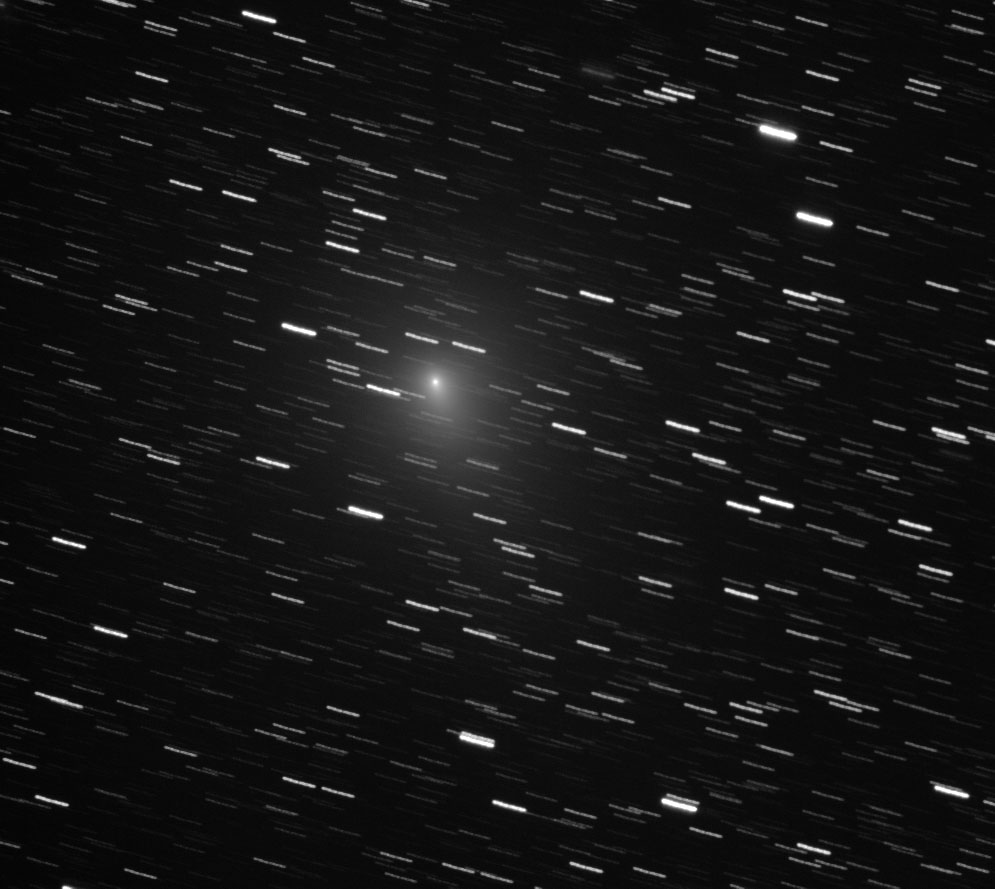
P103HARTLEY-6X2X3.jpg
| With nothing but clouds here not much has been happening but sometimes they open just long enough to get a cloudy shot of Comet Holmes. I've updated my scale image of the comet showing it's growth. Dates are in Universal Time. That means they were taken an evening earlier by your calendar if you live in the US. If you are in Europe or Asia then the date does agree to your calendar though it was taken during your morning or day rather than evening.
In the previous version, I used 2" per pixel as the scale but as I've added days the size of the overall image was growing too big so I have reduced it to 4 seconds of arc per pixel for this image. Since most were taken through clouds it's hard to say I've imaged the true "edge" of the comet. It might be somewhat larger if the clouds didn't hide some of it. In any case on the shot of the 18th, it no longer fit in my field of view. If I centered it no edge would be seen so I moved it off center to just show the pseudo-nucleus at the top and the area of the blue tail seen in my last update at the bottom. That blue gas tail has vanished. I measured the head of the comet to be about 1.6 million miles across. Considering the sun is only 0.86 million miles across that's one huge comet. Yet the real nucleus is likely less than 5 miles across. Thus, this huge thing is mostly nothing. Or as one wag once said; "A comet is something enough different from nothing to be something."
The comet was a bit larger than the full moon in the sky when the last image was taken.
The odd something in the lower right causing the blue arc, the streamer and the odd colored curved things is due to light reflections from Alpha Persei, the brightest star in Perseus. It was just out of the frame and hitting something that caused it to reflect onto the CCD causing these odd features. That happens when something really bright gets into the camera.
The series ended with a shot of Comet Holmes showing the inner streamers that may be due to pieces that broke off from the core. I reprocessed this data using far more sophisticated routines. Since the color data doesn't align perfectly to the comet die to motion between the times the luminosity and color data was taken. I removed the color to help the enhancement process. Now the streamers really stand out. Note the core region is lopsided. I suspect the brighter portion to the lower right is due to a cluster of broken pieces I was unable to resolve. | 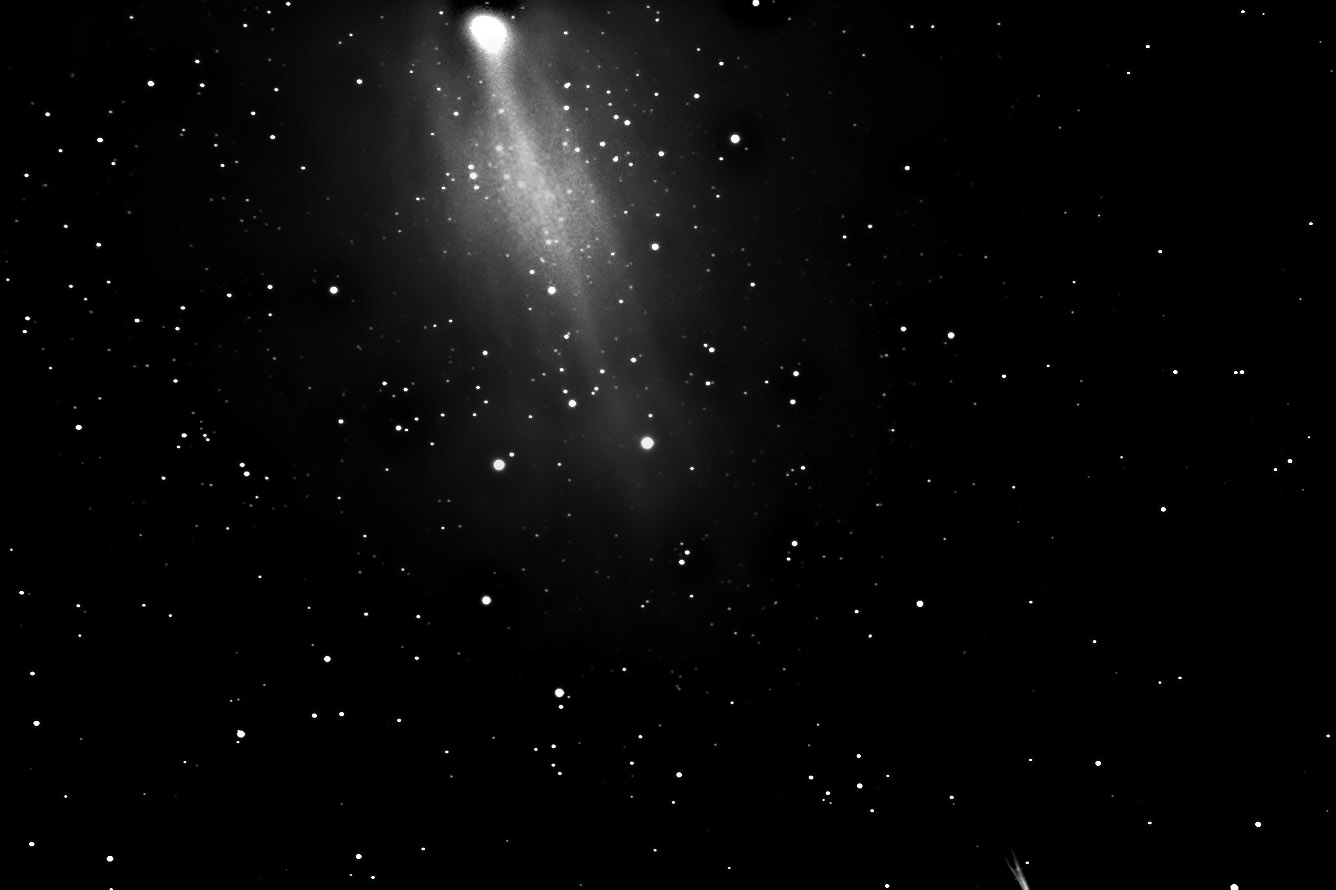
LUM4X1b.jpg
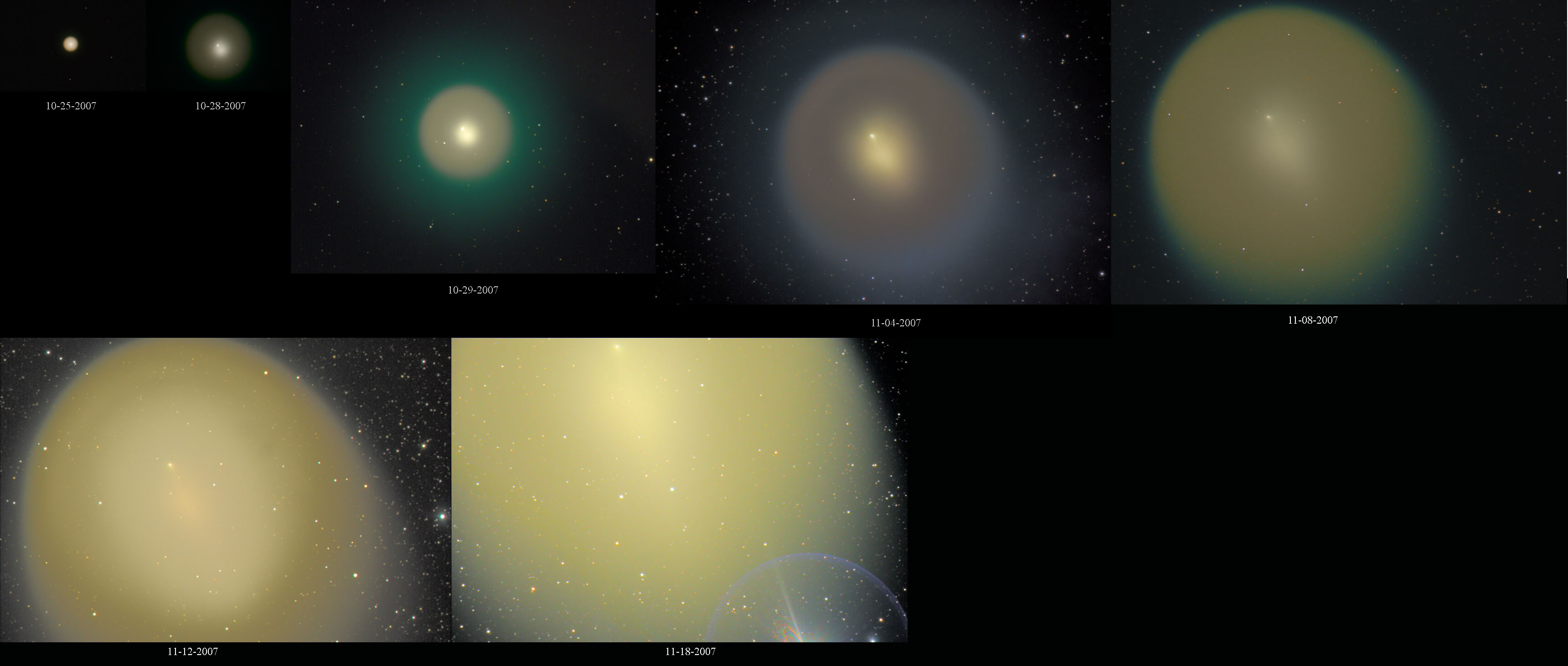
SCALE7.jpg
| P/2010 A2 (LINEAR) is cataloged as a comet but it is no comet. It's the remains of two asteroids that smashed together. I've seen no estimate of when this happened. It was discovered in early January. I've been wanting to try and image it since then but until a couple nights ago I didn't have the skies to do it. This is a preliminary processing of the data. It is moving rather slowly but even that motion (about 0.0032" of arc per second) meant I had to have the mount track this motion to get much due to it being so faint. There's no way to guide on a cloud like this so no guiding was used. I had no way to align the 4 subs so this is just a stack as it came from the camera. I believe it is within 1" of the correct alignment but can't prove this. It's been enlarged from the native 1" per pixel to 0.5" per pixel to better show the detail. This is a crop of the entire image. The full image contained two asteroids only one of which made the cropped version. It is in the lower right corner. It is (50060) 2000 AA68 Since the scope was tracking the debris cloud the asteroid trail is distorted from reality. P/2010 A2 (LINEAR) was moving south-southwest while the other asteroid was moving west-northwest. Asteroids do fall into families with similar orbits. These two are unrelated.
Hubble imaged it about a week ago. Their image is a bit better than mine. You can read more about it at the link below.
http://hubblesite.org/news_release/news/2010-07
14" LX200R @ f/10, 4x10 minutes, STL-11000XM, Paramount ME. Taken binned 2x2 then enlarged 2x to 0.5" per pixel. Related Designations for P2010 A2P2010 A2, | 
P2010_A2L4X10-8r2A.JPG
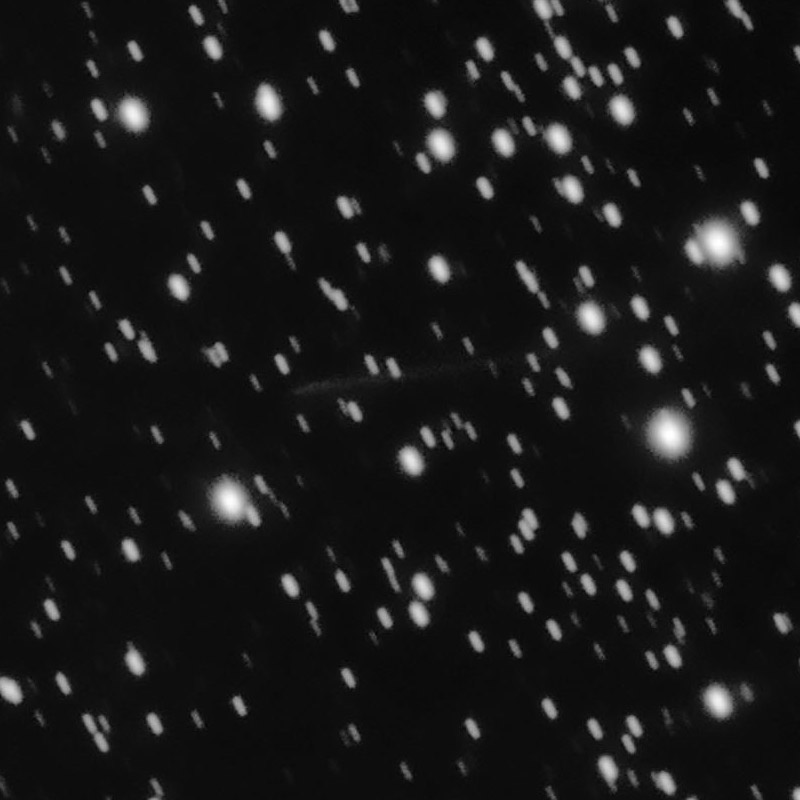
P2010_A2L4X10-8r2ACROP.JPG
| Due to high clouds and a nearly full moon lighting them up something awful I was unable to catch this piece of a comet at closest approach, about 2.2 million miles (3.5 million kilometers). The next night, March 23UT, 2016, cleared when the moon was full and closer to it and it was 2.5 million miles away (4 million kilometers). You have to go back to 1770 for a comet passing any closer. That one was discovered by Charles Messier himself and passed only 1.4 million miles (2.2 million km) from us.
Still, I was able to get 30 minutes worth of one minute images while the Paramount ME tracked the comet based on its orbital elements. Often I find the orbit of something passing close by is changed just enough the predicted path is a few seconds of arc different than it was when the orbital elements were calculated. But being a day late they had been updated and the tracking was so on target I didn't even have to align the 30 images used to make this mono image. Think that was a first and saved a step in processing them. Though the rising moon brightening the sky added a step to keep the background about the same for the movie version.
The comet was at about magnitude was 13.2, down from 12.9 the night before (prediction of the Minor Planet Center). When first detected it was cataloged as an asteroid but then a faint tail was seen causing it to be reassigned as a comet. It is thought to be a piece that broke off from Comet 252P LINEAR on a previous pass by the sun. That comet came by a day earlier at 3.3 million miles (5.2 million kilometers) but was only visible from the southern hemisphere at the time. It is much brighter at magnitude 5 (some say 4.5). It is still too low in Scorpio for me to catch. Maybe in a few days though by then it will be quite a bit more distant. Last I saw it had no sign of a tail, unlike P/2016 BA14, though it shows a nice large coma which seems absent for P/2016 BA14. All my image shows is a 13th magnitude asteroid-like object with a very faint southward pointing tail (looks like a dust tail to me). Radar imaging shows the little comet to be about 1 kilometer (3000 feet) across.
Besides the still image made from 30 one minute images of the comet, I made an animation of the first 15 of them. The images were made binning the camera by a factor of 3. Not because that increases the sensitivity (that's a myth) but because my camera is slow to download images. A full frame takes 27 seconds. That would have increased the time needed to make the image by 11 minutes. Still, the gaps in the star trails show how much the comet moved in those 5 seconds it took to download a frame. It was moving at about 38" of arc per minute. Since I was more than reaching a sky noise level that made the camera's read noise immaterial going longer than 1 minute wouldn't have helped the still image (and would have little effect on the animation) so I settled on 1 minute as a reasonable compromise. I'd likely have reduced an unbinned image to about this image scale to help hide the noise in the very faint tail structure anyway. Since I couldn't stack the frames for the animation the tail was lost in the noise level of a single frame. In fact, I saw no hint of it until I combined about 10 frames, it is very faint.
I hope I never have to image near a full moon again. What a pain it is.
14" LX200R @ f/10, L=30x10'x3, STL-11000XM, Paramount ME | Video: https://images.mantrapskies.com//catalog/OTHER/P2016BA14/P2016BA14.WMV 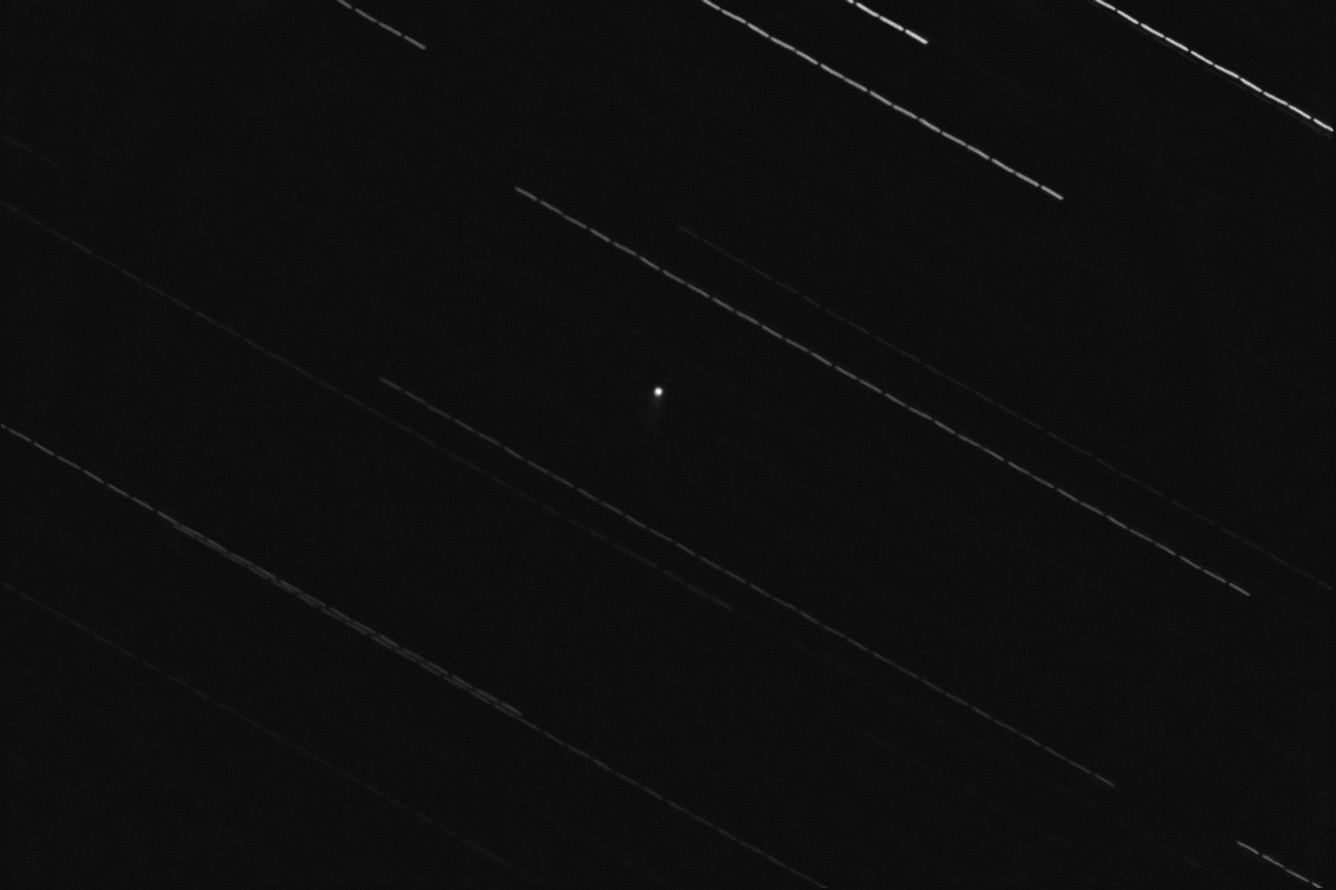
P2016BA14_30X1X3.JPG

P2016BA14_30X1X3CROP.JPG
| While it was cloudy the night 8P/Tuttle passed near M33 it was clear a couple nights later so I was in hog heaven. A clear night after weeks of clouds and no moon. Mr. Murphy though had other ideas. The first target of the night was to be P8/Tuttle. It had been up by the pole for months where a tree hid it from me. Just as it was beginning to move south the clouds rolled in. Now it is moving rapidly south at high speed -- for a comet in the sky. Contrary to TV, comets don't zoom across the sky, Their motion is too small to see without a telescope unless they happen to be passing very very close to us. We had one in 1983 that did move completely across the sky in three nights but still you needed a scope to see this motion as it was much like watching a minute hand on a clock. Come back 10 minutes later and you could see it moved. That was comet Iras-Araki-Alcock, C/1983 H1. While Tuttle is moving "fast" it isn't moving that fast. Still, it was a challenge to image. If I tracked on the comet then the stars showed motion in only 4 seconds looking like short streaks. I needed at least 30 second frames for a low noise shot. Tracking the stars for 30 seconds resulted in a very blurry comet. Yet I needed about 10 minutes of both light and color data and in that time the comet had moved several fields of view of my scope. You can see the result of this in a photo posted to NASA's Astro Image of the Day page of the comet going by M33.
https://apod.nasa.gov/apod/ap080102.html
That funny greenish streak is the comet and shows how far it moved in one hour. It was moving even faster the night I took it.
So why isn't it a green streak in my shot taken at far higher magnification than the APOD image? I put a heck of a lot of work into the processing! I took two sets of images, one tracking the comet and another tracking the stars as they were at the very end of the comet tracked images. I then subtracted the stars out of the one that tracked the comet (easy to do with a routine called sigma reject that ignores an object seen in only one frame as the stars didn't overlap from one frame to the next due to the comet's high speed). Then I subtracted out the comet from the image that tracked the stars. That was hard since the comet is big and thus overlaps itself from frame to frame. Sigma reject only dimmed it and got rid of the nucleus to a great extent. I won't bore you how that was done and still leave stars hiding behind the coma. A Photoshop expert would likely find it easy. I was no expert back in 2008 so it took me many tries but I think I finally mastered it.
Now for Mr. Murphy. For some reason, the power kept going out and short random intervals. The outages lasted only 3 to 5 seconds but that turned off the scope and camera. I had to reboot the computer to regain control of the system. Then turn on the camera and mount. Since this takes a couple minutes the camera's CCD had warmed from its running temperature of -30C. Cooling back took a good 5 minutes. While this was happening I had to turn on the scope and home it so it knew where it was in the sky then slew back to the comet which had moved. If it was a star field shot the motion could be ignored speeding things up a bit but if it had then I had to recenter on the comet, turn on auto-tracking of the comet using its orbital elements and hoping to get another image before the power went out again, often I lost this race. Oddly the problem stopped at 6 a.m. when it got light. This happened for many nights. Calls to the power company got no sympathy saying there was nothing they could do unless it stayed off long enough for me to call it in and they to check their records. Since the outages started when it got dark and quit when light I assume it is something controlled by a light sensor and is off by day. Until it fails completely it will continue to be a problem. Fighting the constant outages I was able to get only minimum data that is somewhat noisy. Since the problem continued until the comet was too far south I never got any more data. We then had a long outage one night. After that, the problem never happened again. I assume the shorting equipment wherever it was finally failed totally.
I now have the entire system on an uninterruptible power supply which carries it through such outages. Since the power company buried the lines in this area such outages are rare but the UPS is still there just in case.
14" LX200R @ f/10, L=2x5' RGB=1x5 minutes, STL-11000XM, Paramount ME Related Designations for P8TUTTLEP8TUTTLE, | 
PTUTTLE_LUM2X5RGB1X5.jpg
| Palomar 1 is in Cepheus about 36 thousand light-years from us and 56,000 light-years from the center of our galaxy. It was discovered by George Abell in 1954 on the original Palomar Observatory Sky Survey plates. Some catalogs show it as a galaxy. The CGCG has this to say about it: "Highly resolved blue pygmy galaxy with possibly compact red nucleus and possible spiral structure. Estimated m(pg) = 17.2." The got the magnitude right but little else. At 79.6 degrees north declination it is one of the most northerly globulars known as most cluster around the core of our galaxy which is well below the celestial equator. In fact, most are too low for me to image from my latitude.
Most globulars are thought to date back to the origin of our galaxy some 10 billion years ago. Palomar 1 is an exception with an age of somewhere between 6.3 and 8 billion years. So it is a young globular. Also, its stars are not very tightly packed and unusually faint. One paper gives three possible reasons for this. "... (A)s gas clouds that survived in the halo after the Milky Way's formation, later to form stars; as captured intergalactic star groups; or as cannibalised dwarf galaxies." Seems to me the latter is most likely given its very high declination. Though it is well within our galaxies halo in which most true globulars reside. http://iopscience.iop.org/1538-3881/115/2/648/pdf/960336.web.pdf
The weather was again a nasty to me. I had planned on doubling my usual frames in hopes of picking out the IFN in the area. But clouds caused the second round to be a near total loss. Only the initial blue frames were usable due to clouds. I didn't discover this until I went to process it a year later. So the IFN is only hinted at and devoid of color as what color I got of it was just too noisy to use. The odd hints of background irregularity is due to the severely underexposed IFN rather than gradients or bad flats.
14" LX200R @ f/10, L=4x10' RG=2x10' B=4x10', STL-11000XM, Paramount ME
| 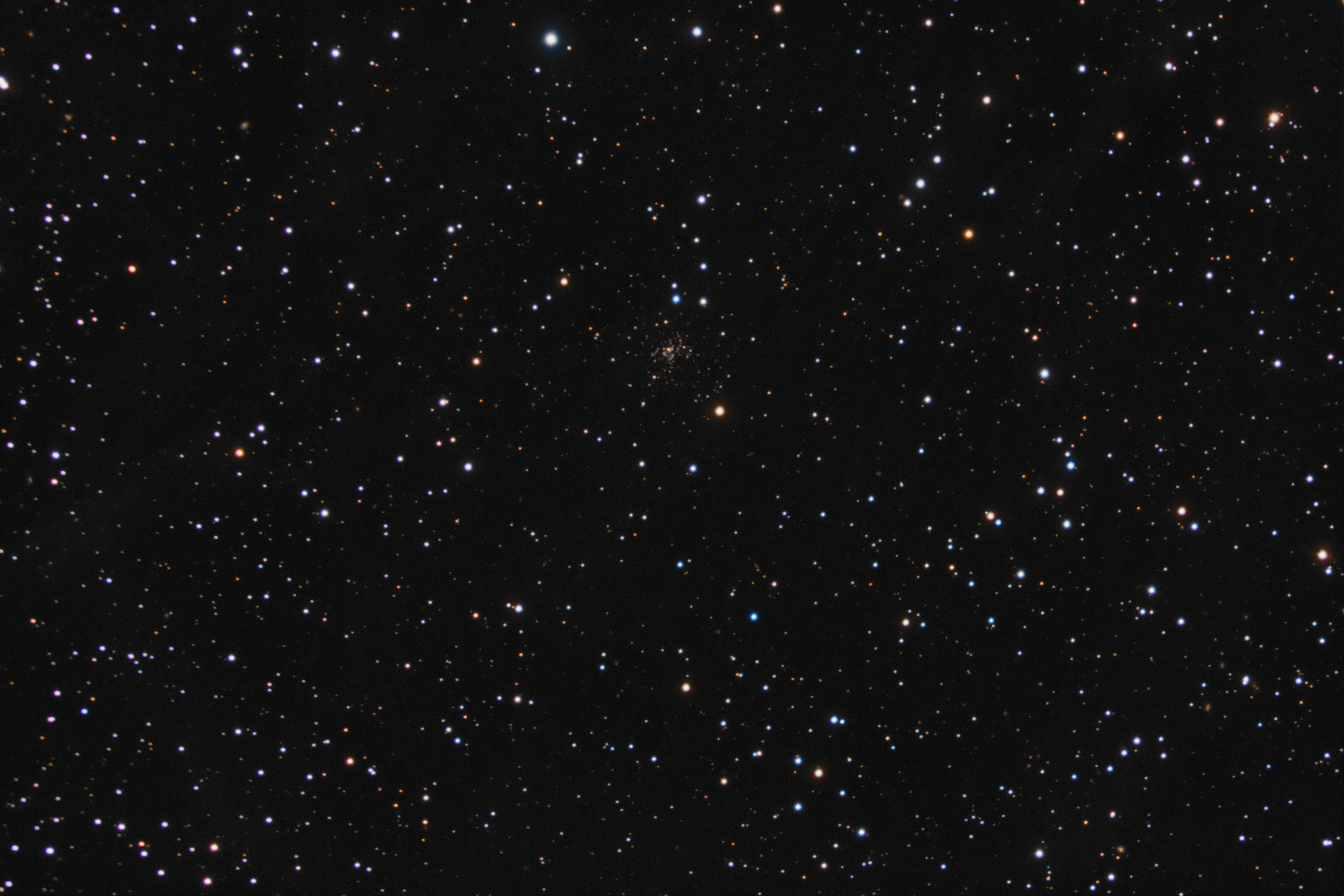
PAL1L4X10RG2X10B4X10.JPG
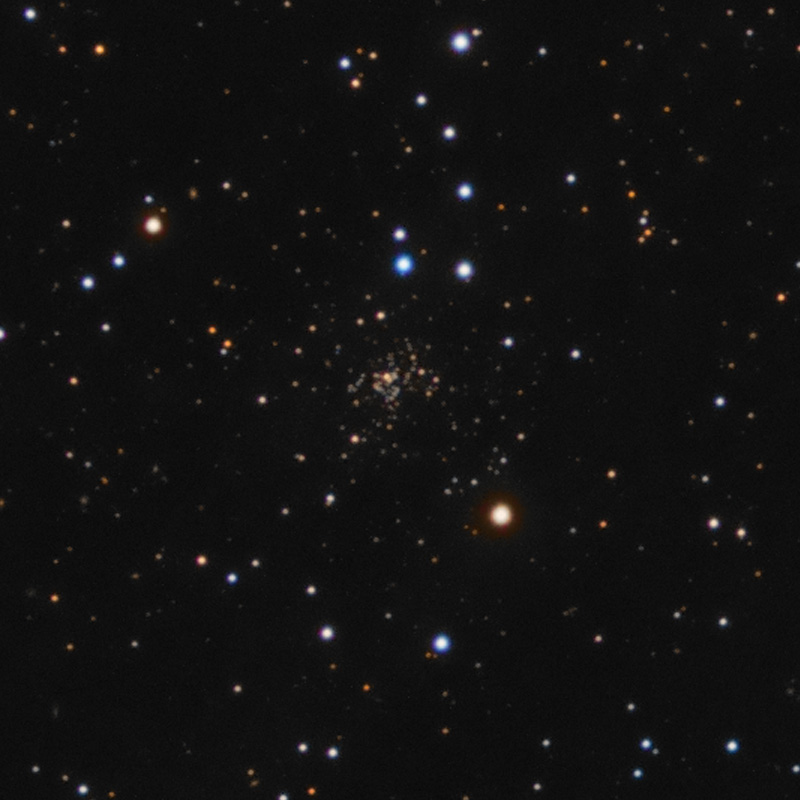
PAL1L4X10RG2X10B4X10CROP150.JPG
| 





















